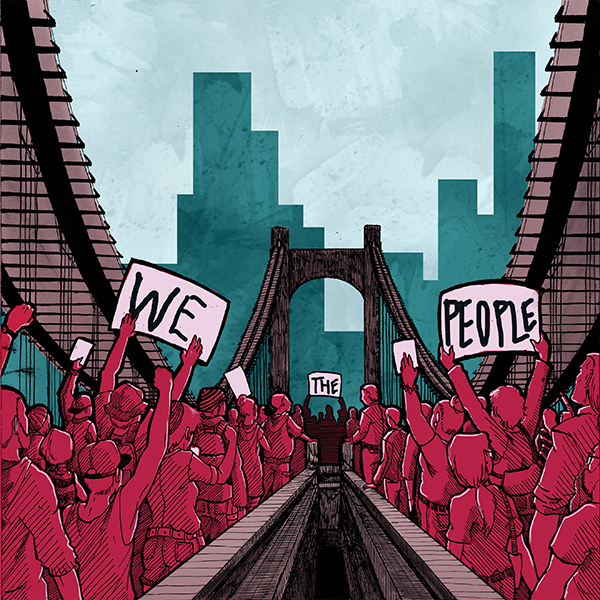Illustration by Chris Bernhardt
A New Era of Civil Disobedience
interview by Heather Shayne Blakeslee
In the book “This is an Uprising: How Nonviolent Revolt is Shaping the Twenty-First Century,” brothers Mark and Paul Engler explore how the strategies and tactics of nonviolent action are actually more effective than armed conflict, and why they are an essential addition to voting when it comes to creating change. Grid spoke with Mark Engler at his home in West Philadelphia.
Why publish this book now?
ME: A lot of social change is sort of long-haul, slow, inch-by-inch work where you’re building organizations over a course of decades. On the other hand, there are these moments of mass revolt that seem to explode onto the scene every once in awhile, where protests are capturing the media attention, changing public conversation. I think that there’s a sense that we’ve seen a lot of that in the last, say, five to 10 years—explosions like Occupy, like the Arab Spring, like Black Lives Matter.
They’re trying to effect political change from outside of the formal structures of politics. We wanted to give a framework for people to understand that and give [it] a bit of vocabulary: What are those uprisings? What impact do they make? Do they have an impact on our political system, and if so, what is that?
You make the distinction in the book between philosophical nonviolence—where the Quaker or Catholic Worker traditions are situated—and those that choose nonviolent action because it’s the most effective tactic.
ME: We want to take that pivot from just looking at nonviolent action as an individual moral philosophy to all sorts of movements that are using nonviolent tactics. Not necessarily from the philosophical connection to the tradition, but because they’ve strategically decided that they’re not going to wage an armed conflict—that that’s not how they’re going to advance their struggle.
You talk about two very different types of organization. One is large-scale but decentralized civil disobedience, the other is structural—akin to union organizing.
ME: The first distinction I would make, particularly because it’s an election year, is we’re told again and again that the way you create change is by electing the right people, or maybe lobbying those people, but really working from inside the process. Everything we’re talking about [in the book] is a different orientation: It’s social-movement-side stuff, it’s looking at people who are organizing outside the formal means of politics—they’re pushing politicians, they’re pushing the system, but they’re using people power and organizing outside of that formal political process.
Now, once we’re there, once we’re with social movements, there’s a lot of thinking about what the best way for people to organize is. We wanted to illustrate one divide that shows up again and again in movements throughout history—and people describe that as “movements” versus “organization.” We describe it as mass mobilization versus structure-based organization.
You have these long-term efforts to build unions, to build community groups, to build up a group like the NAACP. But the NAACP, while it has an important role in the civil rights movement, it isn’t the one that’s organizing the sit-ins, it isn’t the one organizing the freedom rides across the South—it’s Martin Luther King’s group, the SCLC, which organizes mass protests in Birmingham or Selma or St. Petersburg or other places.
Those types of explosions of nonviolent direct action have come from other groups that are often smaller, newer, scrappier. And sometimes there’s a tension between those new startup groups and the more established groups.
You said in the book that you think the real power is going to be in the synthesis of those two approaches.
ME: Right, I think that’s exactly true, and throughout history you see some really interesting examples of people who are using both the power of mass mobilization and the power of organization to try to force change.
Gandhi is a good example of that, where they’re doing these mass campaigns of civil disobedience, which he calls the satyagraha campaigns. He’s also working with the Indian National Congress, which is an opposition organization that ultimately becomes the ruling party of India… There’s a very interesting synthesis and ecology between those different approaches to change.
Black Lives Matter has started to organize chapters and issue guiding principles. “Nonviolence” isn’t named per se, but “loving engagement” is, and they define that as “embodying and practicing justice, liberation and peace in our engagements with one another.” Is that another way of talking about nonviolent action?
ME: If we’re looking at what Black Lives Matter is doing, we look at the many tactics the movement has used—they’re blocking traffic, they’re blocking bridges, they’re doing those types of occupations—those are all tactics that are part of the playbook of civil resistance. So if we look at that wider playbook and say, “OK, how has it been used in the past? How is this particular movement doing it?” some of that comparative work can give us some insights into why this stuff works.
The other thing we see with Black Lives Matter is you get this constant refrain of, “We support your cause, we support your issue, but we just don’t like the way you’re doing it. Can’t you go about this in another way?” And one thing that the comparative work does is it shows that this is actually something that shows up again and again. So, this is the same thing that they said to Martin Luther King… we see patterns, we see trends that happen again and again.
You write in the book, “Movements at their most transformative produce tectonic shifts that make the ground tremble, and although the impact is undeniable, predicting exactly which buildings or bridges will buckle is often difficult. Because of this, activists who generate the tremors often do not receive the credit they deserve in the policy changes that came about.” The Occupy movement is potentially one of those instances, and you cite some real reforms. But it seems the real impact over time has been somebody like Bernie Sanders becoming a viable presidential candidate.
ME: The more structural side of organizing often has a very, very specific demand. So it might be a 25 cent raise for a particular group of workers in a particular classification within a corporation, and they’ll fight the boss for that 25 cent raise.
These mass mobilizations, in order to bring in thousands of people, tens of thousands of people, millions of people—the types of issues they’re bringing in are much broader than that, they’re more symbolically loaded with that wider political significance. And because these movements flare up and seem to fade out, a lot of people say, “Well they didn’t accomplish anything,” while the union or community group can point to a specific reform that they change.
My argument is that while it’s easy to be cynical and say that these [mass] movements didn’t do anything, if you actually track what they did, they can have some very important accomplishments, oftentimes with no budget, no paid staff—this is an outpouring of people power that is not well-resourced to begin with.
So, in the case of Occupy, they had a very clear and documentable impact on the media discussion, which went from the summer before being about austerity, being about the debt ceilings, and changing that to a national conversation that was about inequality, that was about jobs, about the unjust power of the 1 percent versus the 99 percent.
And we’re not satisfied to stop and just say, “Well they changed the conve
rsation.” I think that’s really important, but changing the conversation does have concrete impacts—they passed millionaires’ taxes in California and New York that were considered dead in the water before. They passed a homeowner’s bill of rights in California. In Ohio—where they tried to do an anti-union drive similar to what Scott Walker did in Wisconsin—that effort failed, and it failed with people on the ground organizing, saying, “Occupy totally changed the framework how we were fighting about this, where we went door-to-door and every conversation was in that context of the 99 percent and 1 percent,” and that effort loses where Scott Walker had been able to succeed.
These are long-term changes, too. It’s not just those specific things that we can point to in the first year or six months… We see people like Elizabeth Warren coming into office, we see Bernie Sanders raising a lot of the same issues, echoing a lot of the same rhetoric as Occupy Wall Street, and finding this really surprising—at least to the professional political class—shocking response, a resonance among the public that people wouldn’t have predicted.
You said in the book that people surprise themselves with the amount of power that they actually have.
ME: I think that that’s absolutely true, and that’s another part of the problem of seeing voting as the end all be all.
Mark Engler is an author living in West Philadelphia who co-authored the book “This is an Uprising: How Nonviolent Revolt is Shaping the Twenty-First Century” with his brother Paul Engler, executive director of The Center for the Working Poor.






